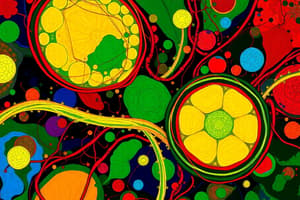Podcast
Questions and Answers
What is the primary function of ATP in biological systems?
What is the primary function of ATP in biological systems?
- To provide structural support to cells
- To store energy for future use
- To serve as a genetic material
- To drive cellular processes (correct)
What type of reaction occurs during the hydrolysis of ATP?
What type of reaction occurs during the hydrolysis of ATP?
- Endergonic reaction
- Anabolic reaction
- Exergonic reaction (correct)
- Catabolic reaction
What does the process of anabolism involve?
What does the process of anabolism involve?
- Breaking down large molecules
- Converting light energy into chemical energy
- Releasing energy
- Synthesizing large molecules from smaller units (correct)
Which of the following describes catabolism?
Which of the following describes catabolism?
What is the result of the condensation reaction involving ADP and inorganic phosphate?
What is the result of the condensation reaction involving ADP and inorganic phosphate?
Which type of energy is harvested from the sun?
Which type of energy is harvested from the sun?
What happens to the energy during the synthesis of ATP from ADP and inorganic phosphate?
What happens to the energy during the synthesis of ATP from ADP and inorganic phosphate?
What constitutes the structure of ATP?
What constitutes the structure of ATP?
What is the primary distinction between oxidation and reduction reactions?
What is the primary distinction between oxidation and reduction reactions?
Which of the following statements accurately describes NADH and NAD+?
Which of the following statements accurately describes NADH and NAD+?
What occurs to the reducing agent during a redox reaction?
What occurs to the reducing agent during a redox reaction?
Which component of the chloroplast is involved in the photosynthetic light-dependent reactions?
Which component of the chloroplast is involved in the photosynthetic light-dependent reactions?
In a redox reaction, what role does the oxidizing agent play?
In a redox reaction, what role does the oxidizing agent play?
In photosynthesis, what is the primary role of the oxidizing agent?
In photosynthesis, what is the primary role of the oxidizing agent?
Which statement about aerobic and anaerobic respiration is correct?
Which statement about aerobic and anaerobic respiration is correct?
Which type of organism uses light as an energy source and organic compounds as a carbon source?
Which type of organism uses light as an energy source and organic compounds as a carbon source?
What characteristic is true of phototrophic energy metabolism?
What characteristic is true of phototrophic energy metabolism?
Which of the following best describes the relationship between oxidation and reduction?
Which of the following best describes the relationship between oxidation and reduction?
Where do carbon dioxide and oxygen exchange occur in leaves?
Where do carbon dioxide and oxygen exchange occur in leaves?
Which stage of photosynthesis is also known as the Calvin-Benson cycle?
Which stage of photosynthesis is also known as the Calvin-Benson cycle?
During the process of oxidation, what happens to the oxidized substrate?
During the process of oxidation, what happens to the oxidized substrate?
What is the primary function of chlorophyll in photosynthesis?
What is the primary function of chlorophyll in photosynthesis?
What type of metabolic process is characterized by reactions that yield energy through oxidation-reduction?
What type of metabolic process is characterized by reactions that yield energy through oxidation-reduction?
What role does the stroma play in chloroplasts?
What role does the stroma play in chloroplasts?
What is the main purpose of the light-dependent reactions in photosynthesis?
What is the main purpose of the light-dependent reactions in photosynthesis?
Where do the light-dependent reactions take place within the cell?
Where do the light-dependent reactions take place within the cell?
Which product of the light-dependent reactions is essential for the Calvin Cycle?
Which product of the light-dependent reactions is essential for the Calvin Cycle?
What process occurs during the Calvin Cycle?
What process occurs during the Calvin Cycle?
Which of the following statements about the light-dependent reactions is false?
Which of the following statements about the light-dependent reactions is false?
What is the primary role of chlorophyll in photosystems?
What is the primary role of chlorophyll in photosystems?
Which of the following correctly identifies the components of Photosystem I?
Which of the following correctly identifies the components of Photosystem I?
What occurs during fluorescence in chlorophyll molecules?
What occurs during fluorescence in chlorophyll molecules?
Which phase of the Calvin Cycle does carbon fixation occur?
Which phase of the Calvin Cycle does carbon fixation occur?
What is the primary output of the light-dependent reactions of photosynthesis?
What is the primary output of the light-dependent reactions of photosynthesis?
What is the immediate product of carbon fixation in the Calvin Cycle?
What is the immediate product of carbon fixation in the Calvin Cycle?
What happens to the plant's access to carbon dioxide when stomata are closed?
What happens to the plant's access to carbon dioxide when stomata are closed?
Which of the following is a product of the reduction phase of the Calvin Cycle?
Which of the following is a product of the reduction phase of the Calvin Cycle?
What is the fate of some of the G3P produced in the Calvin Cycle?
What is the fate of some of the G3P produced in the Calvin Cycle?
Which enzyme is responsible for initiating the process of carbon fixation?
Which enzyme is responsible for initiating the process of carbon fixation?
What is a consequence of photorespiration in plants?
What is a consequence of photorespiration in plants?
Which of the following statements about the Calvin Cycle is true?
Which of the following statements about the Calvin Cycle is true?
What happens to the levels of oxygen gas during the closure of stomata in plants?
What happens to the levels of oxygen gas during the closure of stomata in plants?
Flashcards
Energy
Energy
The ability to promote change or do work.
Chemical Energy
Chemical Energy
Energy stored in the bonds between atoms and molecules.
Solar Energy
Solar Energy
Energy harvested from the sun.
Metabolism
Metabolism
Signup and view all the flashcards
Catabolism
Catabolism
Signup and view all the flashcards
Anabolism
Anabolism
Signup and view all the flashcards
ATP
ATP
Signup and view all the flashcards
Hydrolysis of ATP
Hydrolysis of ATP
Signup and view all the flashcards
Cellular Respiration
Cellular Respiration
Signup and view all the flashcards
Aerobic Respiration
Aerobic Respiration
Signup and view all the flashcards
Anaerobic Respiration
Anaerobic Respiration
Signup and view all the flashcards
Oxidation
Oxidation
Signup and view all the flashcards
Reduction
Reduction
Signup and view all the flashcards
Oxidizing Agent
Oxidizing Agent
Signup and view all the flashcards
Reducing Agent
Reducing Agent
Signup and view all the flashcards
ATP-ADP Cycle
ATP-ADP Cycle
Signup and view all the flashcards
Photosynthesis
Photosynthesis
Signup and view all the flashcards
Photoautotroph
Photoautotroph
Signup and view all the flashcards
Chloroplast
Chloroplast
Signup and view all the flashcards
Chlorophyll
Chlorophyll
Signup and view all the flashcards
Stroma
Stroma
Signup and view all the flashcards
Thylakoid
Thylakoid
Signup and view all the flashcards
Light-dependent Reactions
Light-dependent Reactions
Signup and view all the flashcards
Calvin Cycle
Calvin Cycle
Signup and view all the flashcards
ATP and NADPH
ATP and NADPH
Signup and view all the flashcards
Photosystem II
Photosystem II
Signup and view all the flashcards
Photosystem I
Photosystem I
Signup and view all the flashcards
P680
P680
Signup and view all the flashcards
P700
P700
Signup and view all the flashcards
Photorespiration
Photorespiration
Signup and view all the flashcards
Dehydration in plants
Dehydration in plants
Signup and view all the flashcards
Why do plants close stomata?
Why do plants close stomata?
Signup and view all the flashcards
What happens when stomata close?
What happens when stomata close?
Signup and view all the flashcards
RuBP Regeneration
RuBP Regeneration
Signup and view all the flashcards
What is the role of RuBP in photosynthesis?
What is the role of RuBP in photosynthesis?
Signup and view all the flashcards
Study Notes
Photosynthesis
- Photosynthesis is the conversion of light energy to chemical energy, used in synthesizing organic molecules.
- Organisms involved: Photoheterotrophs and photoautotrophs.
- Location of photosynthesis: Primarily in the mesophyll cells of leaves.
- Plants use the process of photosynthesis to create sugars, which are subsequently used for energy and growth.
Chloroplasts
- Site of photosynthesis in plants
- Parts:
- Outer membrane
- Inner membrane
- Stroma (dense fluid)
- Thylakoids
- Grana (stacks of thylakoids)
- Chlorophyll
Two Stages of Photosynthesis
- Light-dependent reactions:
- Occur in thylakoids
- Convert light energy into chemical energy (ATP and NADPH)
- Produce hydrogen ions (H+)
- Calvin cycle (light-independent reactions):
- Occurs in the stroma
- Carbon fixation, reduction, and regeneration of ribulose bisphosphate (RuBP)
- Requires ATP and NADPH from light-dependent reactions.
Chlorophyll
- Green pigment
- Absorbs light from the visible spectrum, primarily red and violet-blue light, using the energy from the photons for photosynthesis.
- Reflects and transmits yellow and green light, giving leaves their green color.
- Located within the thylakoid membranes of chloroplasts
- Chlorophyll a is the main photosynthetic pigment
- Chlorophyll b is an accessory pigment
Light-Dependent Reactions
- Occur in thylakoids
- Convert light energy to chemical energy (ATP and NADPH)
- Produce hydrogen ions (H+)
- Use photosystems (PSII and PSI)
- Photosystem II (PSII): Water splitting, producing oxygen (O2).
- Photosystem I (PSI): Generating NADPH from absorbed energy.
- Electron transport chain (ETC) involved between these photosystems.
Calvin Cycle
- Occurs in the stroma
- Carbon fixation (using CO2)
- Reduction of fixed carbon to carbohydrates
- Regeneration of ribulose bisphosphate (RuBP) – necessary to continue the cycle
C3, C4, and CAM Plants
- C3 plants:
- Initial CO2 fixation via rubisco produces 3-phosphoglycerate
- C4 plants:
- Minimize photorespiration via PEP carboxylase
- Incorporate CO2 into four-carbon compounds in mesophyll cells
- CAM plants:
- Open stomata at night, fix CO2 into organic acids
- Release CO2 during the day for use in the Calvin cycle
Photorespiration
- A metabolic pathway that occurs when rubisco adds O2 instead of CO2 during carbon fixation in the Calvin cycle.
- Consumes O2 and organic fuel.
- Releases CO2 without producing ATP or sugar.
- A wasteful process that can limit plant growth.
Oxidation and Reduction
- Oxidation: loss of electrons
- Reduction: gain of electrons
- Oxidation-Reduction (redox) reactions are coupled.
Studying That Suits You
Use AI to generate personalized quizzes and flashcards to suit your learning preferences.




